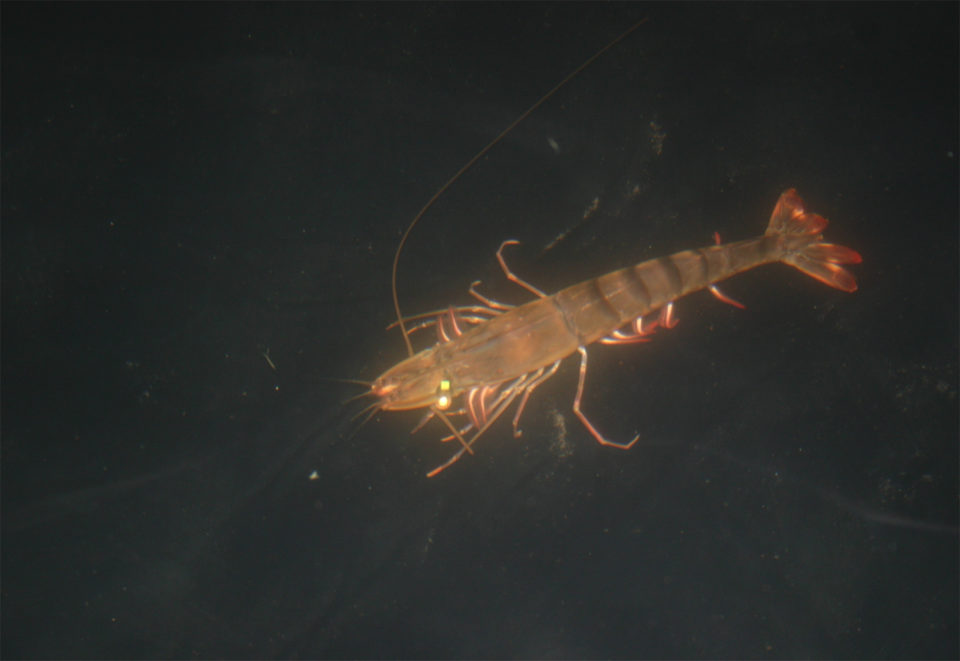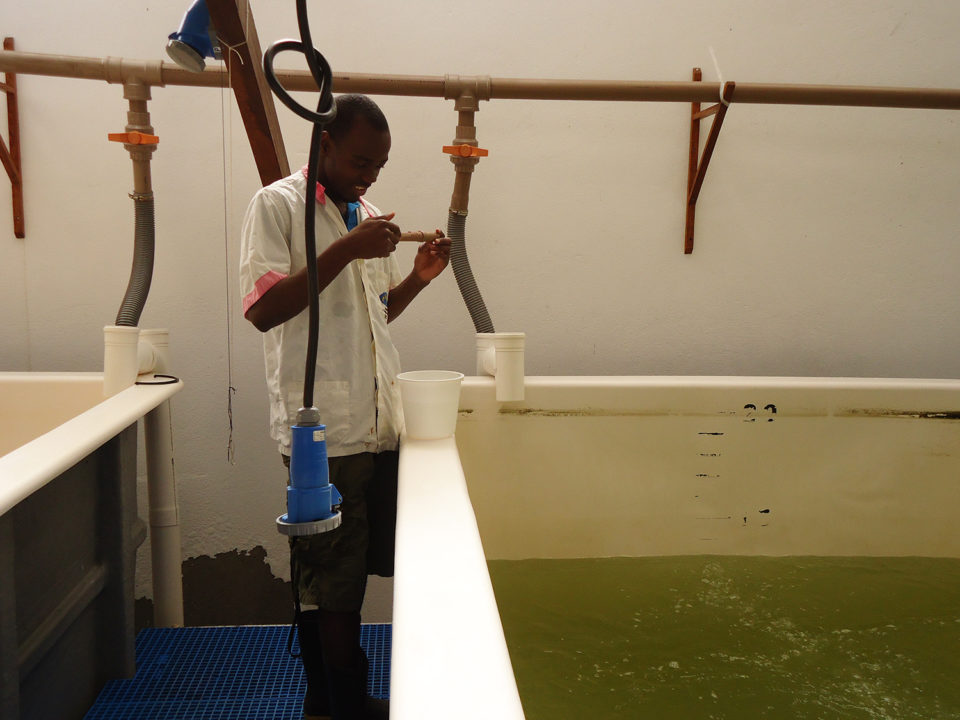Joint project with GAA, Seajoy and Lyons Seafoods seeks to improve broodstock welfare

A multi-year project aimed at improving shrimp hatcheries’ animal welfare practices is nearing conclusion, but initial results released earlier this month show a promising outlook.
A team from the University of Stirling in Scotland reported a viable alternative to eyestalk ablation, a conventional spawn-inducing technique under mounting scrutiny from animal welfare activists and retailers as being potentially harmful or unethical.
Eyestalk ablation– the surgical removal or cutting of a broodstock shrimp’s eyestalk – has been commonplace in hatcheries worldwide for the past quarter-century. The eyestalk contains a complex of glands that influence molting, sexual maturation and spawning processes. Cutting it was a major development in the commercialization of shrimp farming in the 1970s and 1980s, as broodstock females with ablated eyestalks matured faster and released 10 to 20 times more eggs, giving hatchery managers consistent and reliable production.
In response to welfare concerns, researchers at Stirling examined culture environments in Central America where leading commercial producer Seajoy has enjoyed hatchery success with non-ablated Pacific white shrimp (Litopenaeus vannamei) females. As part of the research, animals underwent external-manipulation conditioning, including water temperature, diet and exposure to light, among other factors and tank characteristics. Their findings show that the non-ablated shrimp produce more eggs and nauplii and have higher survival in hatcheries than conventionally ablated broodstock.
The paper, “Reproductive performance and offspring quality of non-ablated Pacific white shrimp (Litopenaeus vannamei) under intensive commercial scale conditions,” was published in the March issue of the journal Aquaculture. The research was a collaborative effort between Stirling, the Global Aquaculture Alliance, Seajoy and Lyons Seafoods. Its origins trace back to an EU-funded SEAT (Sustaining Ethical Aquaculture Trade; 2009 to 2014) project. The Seafish Aquaculture Common issues group flagged ablation as a threat to the continued growth of farmed shrimp in European marketplaces.
“Retailers in the UK were signaling the supply chain that alternatives were urgently required,” the authors – including Prof. David Little – explained to key stakeholders in a memo last week.
Seajoy, a shrimp producer with operations in Central and South America, self-identified as a pioneer in non-ablation techniques. Stirling sent Ph.D. student Simão Zacarias to Honduras to carry out four experiments, two of which are completed, to better understand the biological and economic tradeoffs of the practice. Non-ablation techniques were thought to produce lower yields with poor consistency and higher postlarvae (PL) production costs. Other paper authors include Stefano Carboni and Andrew Davie.
https://www.aquaculturealliance.org/advocate/stirling-researcher-preps-eyestalk-ablation-alternative-trials/
While a comparable level of productivity can be reached using non-ablated female broodstock, the researchers stressed that hatchery managers need to make adjustments at the hatchery and nursery levels, such as doubling the male-to-female ratio from 1:1 to 1:2. Also, they found that administering high-quality supplementary moist feeds, like squid or polychaetes, in pre-maturation conditioning improved non-ablated broodstock condition and performance to a level comparable with ablated animals.
“Supplementary-fed females had higher nutrient reserves in their hepatopancreas, suggesting that their working life could be extended, with the likelihood of economic benefits,” the authors stated in their memo, adding that they are still assessing the costs and benefits of the practice.

Overall, the findings indicate improved broodstock welfare, the authors determined. Hatchery managers, farmers and retailers, they said, should be confident that offspring derived from non-ablated female shrimp perform comparably in all culture stages (larviculture, nursery and grow-out) under commercial conditions.
They also urged aquaculture certification standard setters like GAA (Best Aquaculture Practices), the Aquaculture Stewardship Council and GlobalGAP to include the use of high quality supplementary moist feeds during pre-maturation as a high-welfare management practice, as it improved the animals’ condition and readiness.
It should be noted that there is evidence that the eyestalk ablation procedure has not caused stress to the animals, which return to normal behavior soon after. In a previous article, Zacarias explained to the Advocate that other alternatives to ablation, such as injecting hormones, cause stress and are otherwise impractical.
The research will continue, looking into whether non-ablated female broodstock will have longer, more productive lifespans and gathering more data to complete an economic analysis. They expect those additional findings, due in March, to show that the use of non-ablated shrimp broodstock has a similar production cost for nauplii and PLs as conventional systems.
Follow the Advocate on Twitter @GAA_Advocate
Now that you've finished reading the article ...
… we hope you’ll consider supporting our mission to document the evolution of the global aquaculture industry and share our vast network of contributors’ expansive knowledge every week.
By becoming a Global Seafood Alliance member, you’re ensuring that all of the pre-competitive work we do through member benefits, resources and events can continue. Individual membership costs just $50 a year. GSA individual and corporate members receive complimentary access to a series of GOAL virtual events beginning in April. Join now.
Not a GSA member? Join us.
Author
-

James Wright
Editorial Manager
Global Aquaculture Alliance
Portsmouth, NH, USA
Tagged With
Related Posts

Health & Welfare
Seajoy’s ablation-free shrimp answers emerging welfare concern
Removing the eyestalk of broodstock female shrimp aided in the explosive growth of commercial-scale aquaculture. An undertaking by a Central American shrimp farmer has shown that producing shrimp without ablation can ease animal welfare worries without the feared drop in production.

Health & Welfare
Stirling researcher preps eyestalk-ablation alternative trials
University of Stirling Ph.D. student Simão Zacarias, who is from is Beira, Mozambique, will soon travel to Isla del Tigre, Honduras, to document evidence showing the benefits of breeding shrimp without eyestalk ablation. His is a journey of hopeful discovery.

Health & Welfare
With animal welfare an emerging consumer concern, fish farmers take stock
Food producers are educating themselves on the latest in animal health and welfare and humane harvesting and processing practices. A recent webinar highlighted issues specific to aquatic animals.

Health & Welfare
Study ties animal welfare practices to consumer purchasing
There’s an opportunity to expand the U.S. market for farmed seafood if the aquaculture industry were to more widely adopt humane production practices, according to a study by Changing Tastes and Datassential.

